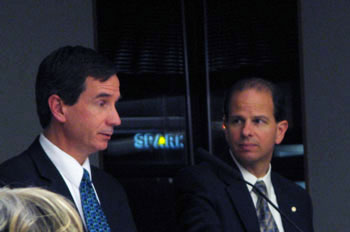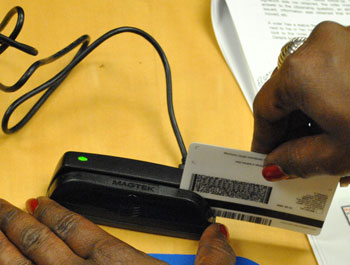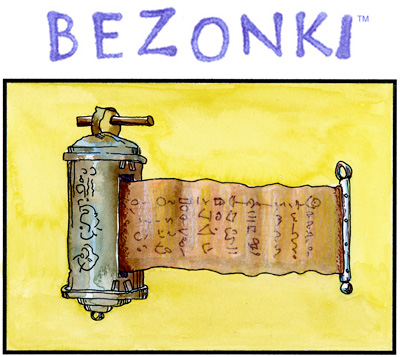Archive for May, 2012
Liberty & Maynard
Changing of the marquee at the Michigan Theater. [photo]
Murray & Liberty
Two blue jays in concert chasing a red squirrel up and over the roof of a garage. Squirrels are never afraid of me.
Prices to Get Tweaked as Parking Deck Opens
Ann Arbor Downtown Development Authority board meeting (May 2, 2012): The one action item on the board’s agenda was a resolution directing its operations committee to start applying demand-management principles to the pricing for permits in Ann Arbor’s public parking system. The resolution, which passed unanimously, notes that the goal of the pricing strategy is to attract patrons to those structures that are located farther away from the University of Michigan campus.

Ann Arbor Downtown Development Authority board members Roger Hewitt (left) and Keith Orr. They're examining a Girl Scout badge created for assisting in the Downtown Blooms event. The car on the wall in the background is a mockup of the planned wayfinding system for the levels of the new underground parking structure, anticipated to open by mid-July. (Photos by the writer.)
One of those structures farther west of the campus is the new underground parking garage on South Fifth Avenue, which is nearing completion. The garage, which the DDA is currently calling the “Library Lane” parking structure, is now expected to open by the time the art fairs begin, which this year fall on July 18–21. South Fifth Avenue between Liberty and William is expected to re-open by Memorial Day.
A characterization of that timing as “on schedule” was disputed during public commentary by Ali Ramlawi, owner of the Jerusalem Garden restaurant. Jerusalem Garden is adjacent to the construction site. Ramlawi noted that the structure was originally due to be completed by August 2011.
The future use of the top of the underground garage was the subject of public commentary from advocates who’d like to see it used as a green plaza. That suggestion was met with remarks from mayor John Hieftje, who sits on the DDA board, with a description of his expectation that three major parcels would soon be incorporated into the city’s park system – 721 N. Main, 415 W. Washington, and the MichCon property (located between the Amtrak rail station and the Huron River near the Broadway bridges). Hieftje’s point was that the additional financial burden for the maintenance of those parcels as parks might impact the city’s ability to add a downtown green plaza to the park system.
Requests for better information about the parking system and suggestions for disseminating information about the availability of open parking spaces were topics of additional public commentary.
Although it was not an action item, the board discussed a draft policy on supporting “brownfield” projects – a policy prompted by discussions at the board’s partnerships committee over the last few months. [.pdf of draft DDA brownfield policy]
The committee has been discussing a proposal by Dan Ketelaar for support of a proposed development at 618 S. Main, which received a positive recommendation from the Ann Arbor planning commission on Jan. 19, 2012. If the project moves forward, the 7-story building would include 190 units for 231 bedrooms, plus two levels of parking for 121 vehicles. Ketelaar has estimated that the tax on the increment between the current valuation of the property and the final built project would yield around $250,000 a year in TIF (tax increment finance) revenue to the DDA. If adopted as it’s currently worded in the draft, the formula in the policy would translate into up to $625,000 of support for 618 S. Main.
The board also received updates on the third-quarter financial statements for the DDA, as well as an update on the Connection William Street planning project. [Full Story]
Fountain & Cherry
Waterhill Music Fest signs popping up all over the neighborhood. [photo]
Washtenaw Community College
Family Learning Institute spelling bee getting under way. [photo]
Main Street
Bags of chips from Ann Arbor Tortilla Factory being distributed (free) in front of Verizon with $10 gift card.
Seventh & Washington
Made a couple of passes by this corner in the afternoon. Both times people with clipboards watching, writing, and crossing. Someone is measuring compliance with the crosswalk ordinance. Everyone was stopping as they should each time I went by.
A2-Ypsi: May 8 Election
The Ann Arbor/Ypsilanti Regional Chamber of Commerce weighs in on ballot issues facing voters in Ann Arbor and Ypsilanti on Tuesday, May 8. The chamber supports an 0.5 mill tax to fund a $45.8 million technology bond for the Ann Arbor Public Schools. [.pdf of chamber position statement on AAPS bond] But the chamber opposes two ballot proposals in Ypsilanti: (1) a 1% income tax on businesses and residents, and an 0.5% income tax on non-residents; and (2) a tax to cover $18.2 million in payments related to the Water Street project – 4.94 mills to be levied in 2012, and an estimated simple average annual millage rate of 5.40 mills. [.pdf of chamber position statement on Ypsilanti ... [Full Story]
Plymouth Road & Huron Parkway
NCRC Guard Geese/Goslings Update. There are six goslings now, they’re getting bigger, and they’re having family outings! (Link to previous items on the NCRC Guard Geese) [photo]
Fourth Ave. & Catherine
Robert (vendor #17) sells me a copy of the Groundcover News in front of Cafe Verde, insisting that I remember his name and vendor number. “Watch for my article in the next issue.”
What a cool project.
Armentrout Eyes Ward 5 Council Race
The city of Ann Arbor clerk’s office filing records indicate that Vivienne Armentrout, a former Washtenaw County commissioner, pulled petitions on Friday, May 4 for the Ward 5 Ann Arbor city council race. Armentrout is a Democrat.
Carsten Hohnke, who was first elected in 2008 after defeating Armentrout in a close Democratic primary that year, announced on April 21 his decision not to seek re-election this year.
An Ann Arbor resident since 1986, Armentrout is a freelance writer and author of the Local in Ann Arbor blog, which focuses on the Ann Arbor area and frequently highlights public transit and other planning issues. She served on the Washtenaw County board of commissioners from 1997-2004.
In November 2010 she ran for a position on the board … [Full Story]
Detroit & Kingsley
Picketing of job site for Zingerman’s expansion project, with signs calling for “local jobs for local workers.”
Main & Miller
Community High School jazz musicians playing a drop-in set at Mighty Good Coffee. [photo]
AAPS Hears from Community: Keep Clemente
Ann Arbor Public Schools Board of Education regular meeting (April 25, 2012): The board received a formal presentation of the proposed fiscal year 2013 budget. The board is not required to approve the budget until June 30.
At the meeting, 33 parents, students, and staff responded to proposed budget cuts that would affect transportation, Roberto Clemente Student Development Center, and music camps. The total time allotted for public commentary by the AAPS board is 45 minutes. So speakers wanting to address the school board at public commentary at the April 25 AAPS school board meeting were limited to 1 minute and 22 seconds, which was rounded up to a minute and a half.

Brian Marcel and Scott Menzel gave the AAPS board an update on the transportation services provided by WISD to the district as part of a consortium of other districts.
After hearing the budget presentation, board members shared some of their individual thinking on how best to address the projected $17.8 million deficit facing the district next year. AAPS is sponsoring two community budget forums to get additional feedback on the budget proposal. Both start at 6:30 p.m. The first will be held on May 7 at the Pioneer High School Cafeteria Annex and the second one a week later on May 14 at the Huron High School Cafeteria.
Support of the upcoming technology bond millage came up multiple times at the meeting as one way local residents could have an impact on the funding crisis facing local schools. AAPS district voters will decide that issue on May 8.
Also at this meeting, longtime environmental educator Bill Browning was honored by the board for his years of dedication to the district, as well as his recent $30,000 donation to the AAPS Science and Environmental Education Endowment Fund. [Full Story]
In the Archives: Poison Pages
A second-floor shelf of University of Michigan’s Buhr book storage facility contains Michigan’s single most dangerous book.
It is one of only two known copies to exist in the state. If not for its historical importance, even the most fervent bibliophile might agree: the fewer copies in the world the better.
“Shadows from the Walls of Death” is dangerous not in the sense of a book containing radical ideas. Nor is it dangerous in the way a bomb-building manual might be. In fact, after the title page and preface, the following 86 pages, each one measuring about 22 by 30 inches, contain no printed words at all.
Michigan State University holds the other copy of “Shadows” in its Special Collections library division. The volume is sealed in a protective container, and each page is individually encapsulated.
Prospective “readers” of “Shadows” at the Buhr building must wear blue plastic protective gloves. During a visit to the Buhr some days ago, the book was wheeled out slowly on its individual cart. The marbled pattern on the cover showed through a protective thick-gauge plastic bag.
I held my breath as I gingerly eased open the cover, and while “reading” the pages I was careful to avoid any skin contact. “Shadows” is saturated with a deadly amount of arsenic. [Full Story]
Lacrosse (JV): Skyline 6, Pioneer 0
Game was played Wednesday, May 2 at Pioneer. Skyline goals: Bacon; Wegryn (2); Bollick; Hiltner; Schneider.
County Supports Clean Air Act
A resolution passed by the Washtenaw County board of commissioners at their May 2, 2012 meeting expresses support for the U.S. Clean Air Act, and opposes “attempts to weaken, dismantle, overrule or otherwise impede the Environmental Protection Agency from enforcing or implementing” the act. Rob Turner (R-District 1) voted against the resolution, citing concerns about the impact on business and employment. Dan Smith (R-District 2) abstained.
The resolution was requested by Dick Fleece, director of the county’s public health department. A staff memo accompanying the resolution notes that since the Washtenaw County Clean Indoor Air Regulation was implemented in 2003, the number of county residents using tobacco has dropped from 18% in 2003 to 12% in 2012. The memo notes that ”supporting the … [Full Story]
Rabhi Appointed to Food Policy Council
Yousef Rabhi, a Washtenaw County commissioner representing District 11 in Ann Arbor, was appointed by his colleagues on the county board to serve on the new Washtenaw Food Policy Council. The vote came during the board’s May 2, 2012 meeting.
The county board approved the creation of the council at its March 21, 2012 meeting. The council’s goal is to support local “small and mid-sized farmers by fostering policies that encourage local food purchasing and production,” according to a staff memo. Among other activities, the council could also: recommend policy changes at the local, state and national levels; provide a forum for discussing food issues; encourage coordination among different sectors of the local food system; evaluate, educate, and influence policy; and launch or support programs and … [Full Story]
Initial OK for Sugar Creek Drain Bonds
Acting on a request from water resources commissioner Janis Bobrin, the Washteanw County board of commissioners gave initial approval to pledge the county’s full faith and credit for up to $270,000 in bonds to fund an extension of the Sugar Creek drainage district.
The project – which in total is budgeted at $349,899 – was requested by the Washtenaw County road commission. It entails relocating a portion of the county drain, including a section of 1,850 feet adjacent to Platt Road between Judd and Stoney Creek roads in York Township. A second phase includes removing sediment and vegetation, as well as making wingwall repairs, at the drain crossings of US-23, McCrone Road, and Gooding Road.
The Sugar Creek drainage district covers parts of York … [Full Story]
DDA to Mull Brownfield Policy
At its May 2, 2012 meeting, the DDA board was presented with a draft policy on supporting “brownfield” projects – a policy prompted by discussions at the board’s partnerships committee over the last few months. [.pdf of draft DDA brownfield policy] The board was not expected to act on the policy, and did not vote.
The committee has been discussing a proposal by Dan Ketelaar for support of a proposed development at 618 S. Main, which received a positive recommendation from the Ann Arbor planning commission on Jan. 19, 2012. The 7-story building would include 190 units for 231 bedrooms, plus two levels of parking for 121 vehicles. Ketelaar has estimated that the tax on the increment between the current valuation … [Full Story]
Monthly Parking: Tweaked to Manage Demand?
At its May 2, 2012 meeting, the board of the Ann Arbor Downtown Authority approved a resolution that authorizes its operations committee (aka bricks & money and transportation committee) to use demand management strategies to price monthly parking permits in Ann Arbor’s public parking system. The goal of adjusting monthly parking permit rates is to expand campus-area parking to structures other than those immediately adjacent to the University of Michigan campus. In broad strokes, “demand managent strategies” means pricing the most desirable parking options higher than those that are less desirable.
The move comes as the opening of the new underground parking structure on South Fifth Avenue, offering around 700 additional total spaces, is set to open by the start of the Ann … [Full Story]
1414 Wells
Burns Park students and staff participating in ACES (All Children Exercise Simultaneously). [link]
Main Street
Groups of students from Forsythe Middle School are on a scavenger hunt to learn more about the downtown. At Peaceable Kingdom, the store’s Jack Russell terrier gets most of the attention.
Fifth & Washington
Main & Washington
Milestone: The Science of Journalism
Editor’s note: The monthly milestone column, which appears on the second day of each month – the anniversary of The Ann Arbor Chronicle’s Sept. 2, 2008 launch – is an opportunity for either the publisher or the editor of The Chronicle to touch base with readers on topics related to this publication. It’s also a time that we highlight, with gratitude, our local advertisers, and ask readers to consider subscribing voluntarily to The Chronicle to support our work.
Description. Analysis. Explanation. Remember those three concepts.
Last month I participated in a video teleconference with students who are members of Bowling Green State University’s Online News Association. It’s a group that’s advised by department of journalism and public relations faculty member Dave Sennerud. The focus that evening was on hyperlocal news sites, which is a specialty of BGSU’s Mike Horning. Horning recently completed a dissertation on that topic at Penn State University.
I view any interaction like that video conference as a chance to evangelize a bit about The Chronicle’s approach to writing the news – which prioritizes description over storytelling. And that chance came when a general question was posed about advice to journalism majors who will be entering the field.
My advice: Got a journalism degree? That’s great, but I’d prefer that you were a scientist.
As we used to say back in Indiana, that is currently a mute point. Right now, although the amount of advertising and individual subscriber support continues to increase each month, not enough readers subscribe voluntarily and not enough advertisers purchase ads for us to contemplate hiring additional full-time staff. But that’s the direction we’re working towards, to supplement our freelance reporters and to make our own workload more sustainable.
So while we’re not in a hiring mode now, we do anticipate a time when we’ll be making those decisions, and it makes sense to think about the type of skills we’d like a reporter to have.
The main skill a Chronicle reporter needs – and the one I think the entire field of journalism has largely forgotten – is the ability to describe, in detail, an event or an issue in a way that is designed mostly to engage the intellect of readers, not their emotions. It’s actually a scientific skill. But that approach to writing the news contrasts with the way institutional journalism has evolved to train its next generation of practitioners.
If basic description is a part of traditional, institutional journalism, it’s typically well-hidden, behind attempted analysis and attempted explanation – in the form of “stories.” And when I write the word “stories,” I put those scare quotes around it consciously. That’s so it’s not confused with other ways of referring to items that might appear in a journalistic publication, like “articles,” “briefs” or “reports.”
Most items that are written by traditional journalists these days are attempts at “stories” in that term’s literal sense – a narrative with a conflict, a plot, and characters who say interesting and provocative things. But as a reporter, if you begin with the idea of a story you want to tell, you’ve ordered your task backwards. [Full Story]
New Technology for Tech Bond Election
On Tuesday, May 8, Ann Arbor voters will be asked to approve a bond to support investments in technology for Ann Arbor Public Schools. And it turns out that new technology will play a part in the Ann Arbor city clerk’s implementation of the election.

A driver's license can be swiped for automatic lookup in the electronic pollbooks that will be deployed at eight precincts for the May 8 election. The voting process itself will take place using the usual paper ballots.
In eight of the city’s 37 precincts, election workers will deploy electronic pollbooks (EPBs) – information downloaded onto laptop computers (the night before the election) from the state’s qualified voter file. (The count of 37 precincts arises from the combination of several of the city’s usual 48 precincts for this local election.)
The laptops are supplied to the city of Ann Arbor by the state of Michigan through the Help America Vote Act. Michigan’s secretary of state’s office told The Chronicle in a phone interview that of Michigan’s roughly 1,500 different municipalities across Michigan about 800 will use EPBs in the May election, and more than 1,000 will use them in the August primaries. In 2009 40 different municipalities had tested the system.
Ann Arbor is piloting the EPBs in eight precincts this spring, with an eye toward expanding citywide by the November 2012 presidential election. Voters in the eight precincts won’t need to do anything different to prepare to vote. The voting itself won’t take place electronically. Voters will still fill in ovals on paper ballots. EPBs are simply for pollworkers to check in voters and perform record-keeping tasks at the precinct through voting day.
The eight precincts where EPBs will be deployed on May 8 are 1-8 (Skyline High School), 1-10 (Arrowwood), 2-5 (Ann Arbor Assembly of God), 2-7 (King Elementary School), 4-4 and 4-8 combined (Pioneer High School), 5-3 (Second Baptist Church), 5-6 (Eberwhite School), and 5-11 (Forsythe Middle School).
Voters will have mostly the same experience voting that they’ve always had. For example, they’ll still need to bring a photo ID. If that ID is in the form of a Michigan driver’s license, a voter might enjoy an incrementally faster check-in time at the polls. That’s because election workers will be able to scan a driver’s license for automatic lookup in the EPB.
The city clerk trained election inspectors in the use of EPBs at three sessions last week. The Chronicle attended the Thursday, April 26 session. [Full Story]
Commission Votes against Marijuana Revision
On a unanimous vote, the Ann Arbor planning commission recommended denial of a proposed change to the city’s zoning code for medical marijuana dispensaries and cultivation facilities. The vote came at the end of the commission’s May 1, 2012 meeting.
The city’s medical marijuana licensing board had recommended one change – to strike the following sentence from the zoning ordinance: “Medical marijuana dispensaries and medical marijuana cultivation facilities shall be operated in compliance with the MMMA (Michigan Medical Marijuana Act).” [.pdf of the recommended zoning ordinance change]
The board’s recommendation had been sent to Ann Arbor city council. But at their April 2, 2012 meeting, councilmembers voted 9-1 to instead direct the planning commission to review the medical marijuana zoning ordinance. … [Full Story]
Chalmers Place Parking Plan Rejected
At its May 1, 2012 meeting, the Ann Arbor planning commission recommended denial of three resolutions related to a proposal for Chalmers Place, at 2090 Chalmers Drive near the intersection with Washtenaw Avenue: (1) rezoning a vacant lot from R1B (single-family residential) to P (parking); (2) authorizing the disturbance of a 25-foot natural features open space; and (3) a site plan for the parking lot. The site is west of Arborland Mall. All votes were 1-7, with support only from commission chair Eric Mahler. Bonnie Bona was absent.
The city’s planning staff had also recommended denial of the proposal because it did not conform to the city’s master plan for that area, and because a parking lot would cause greater disturbance to the … [Full Story]






